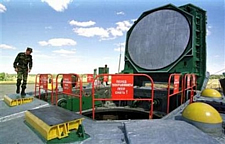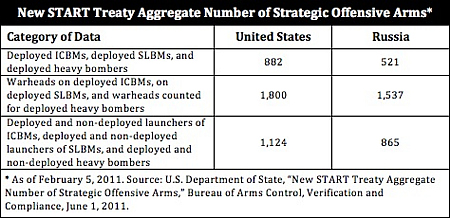New START Aggregate Numbers Released: First Round Slim Picking
 |
| You won’t be able to count SS-18s in the New START aggregate date. |
.
By Hans M. Kristensen
Russia and the United States have released the first Fact Sheet with aggregate numbers for the strategic offensive nuclear forces counted under the New START treaty.
It shows that Russia has already dropped below the New START ceiling of 1,550 accountable deployed warheads and the United States is close behind, seven years before the treaty is scheduled to enter into effect (it makes you wonder what all the ratification delay was about).
But compared with the extensive aggregate numbers that were released during the previous START treaty, the new Fact Sheet is slim picking: just six numbers.
Unless the two countries agree to release more information in the months ahead, this could mark a significant step back in nuclear transparency.
The Aggregate Numbers
The Fact Sheet includes six numbers for three categories of counted U.S. and Russian strategic nuclear arms under the treaty:

United States
The table lists 882 deployed delivery vehicles. Since we know this includes 450 ICBMs and 288 SLBMs, the number of bombers counted appears to be 144. Less than half of those (about 60 B-2 and B-52H) are actually assigned nuclear missions, the balance being “phantom” bombers (B-52H and B-1B) that have some equipment installed that makes them accountable under the treaty.
The 1,800 deployed warheads include approximately 500 on 450 ICBMs and approximately 1,152 on 288 SLBMs. The remaining 148 warheads constitute the remaining “fake” count of one weapon per deployed bomber. That means our estimate was only four warheads off (!).
If subtracting the 144 “fake” bomber weapons, the actual number of U.S. deployed strategic warheads on ICBMs and SLBMs is 1,656, only about 100 warheads from the New START ceiling. The actual number of bomber weapons present at the bases, we estimate, is 300 or less. They are not deployed on the bombers, so they are not counted by New START, but they were counted by the United States during the now-expired Moscow Treaty (SORT). So the real number of operationally available warheads may be around 1,950, which is what we estimated in March.
Another 2,290 non-deployed strategic warheads are in reserve and there are about 760 non-strategic warheads for a total stockpile of approximately 5,000 warheads. Another 3,500 or so warheads are awaiting dismantlement for a total inventory of roughly 8,500 warheads.
The total number of 1,124 deployed and non-deployed missiles and bombers shows that there are 242 non-deployed missiles and bombers. That number includes 48 SLBMs for two non-deployed SSBNs and additional test SLBMs, reserve Minuteman ICBMs and 50 retired Peacekeeper ICBMs, and heavy bombers in overhaul.
The United States has declassified considerable information in the past and hopefully will continue to do so in the future, so the limited aggregate numbers has fewer implications than in the case of Russia. But it would help to see a breakdown of bombers and non-deployed missiles.
Russian Federation
The effect of the limited aggregate numbers has a much more significant effect on the ability to understand the Russian nuclear posture. Most important is the absence of a breakdown of strategic delivery vehicles.
The number of deployed delivery vehicles is listed as 521. The final aggregate number from the expired START treaty was 630 as of July 1, 2009. Not surprisingly, a reduction because the SS-18, SS-19, SS-25 and SS-N-18 are being phased out. But the limited aggregate information makes it impossible to see which missiles have been reduced.
In our latest estimate we counted 534 deployed delivery vehicles, or 13 more than the New START data. The difference may reflect that some SLBMs on Delta IV SSBNs were not fully deployed and a slightly different composition of the ICBM force.
The Fact Sheet lists 1,537 deployed warheads, which actually translates into 1,461 warheads because 76 of them are “fake” bomber weapons. That means Russia has already met the warhead limit of New START – seven years before the treaty enters into effect.
Despite the uncertainty about the force structure, our latest estimate of Russian strategic nuclear warheads deployed on ICBMs and SLBMs was only 122 warheads off.
The aggregate deployed warhead number also more or less confirms long-held suspicion that Russia normally loads its missiles with their maximum capacity of warheads, in contrast to the United States practice of loading only a portion of the warheads.
That means that Russia only has comparatively few strategic warheads in reserve (essentially all bomber weapons). New START does not count such warheads, nor does it count 3,700-5,400 non-strategic warheads in storage or some 3,200 warheads awaiting dismantlement, for a total inventory of up to 11,000 warheads.
The total aggregate number for deployed and non-deployed delivery vehicles is listed as 865. That shows us that Russia has 344 non-deployed delivery vehicles, a considerable amount given the relatively limited size of their deployed force of 521 delivery vehicles. Since Russia has a limited number of bombers more or less exclusively committed to the nuclear mission, the non-deployed delivery vehicles mainly include retired ICBMs. It would be good to hear whether they will be destroyed or stored.
Additional releases
Each of the two parties to New START can decide under the treaty to release additional information to the public about their own nuclear postures. Given the limited information in the aggregate numbers Fact Sheet, it would be a huge disappoint if they don’t.
I understand from the U.S. government that it is planning to do so later this year, and it is important that Russia considers doing so as well.
Under the terms of the treaty the two parties may also agree to jointly release additional information.
Implications
At a first glance the aggregate numbers released by the United States and Russia under the New START treaty is a huge disappointment. It represents a step back in nuclear transparency compared with the standard set by the same two countries under the previous START treaty.
Earlier last month, Ambassador Linton Brooks, Ambassador Jack Matlock and Secretary William Perry joined FAS in calling on the United States and Russia to continue to meet this standard.
We have yet to receive a formal reply but the aggregate numbers Fact Sheet is a reply of sort.
It ought to be a natural that international nuclear transparency is increased with each new treaty, that previously unaccounted categories are brought under accounting, and that uncertainties are cleared up. Moreover, international nuclear transparency means transparency not just for the two parties to the treaty but for the international community as well.
The aggregate numbers Fact Sheet includes the total number of warheads actually deployed on ICBMs and SLBMs, an important improvement from the previous treaty. But the breakdown of number of delivery vehicles and deployment locations has moved into the black.
As mentioned above, the United States and Russia have the right under the treaty – individually or jointly – to release additional information about their nuclear force structures.
It is essential that they do so and continue to do so with each future aggregate numbers Fact Sheet release. Otherwise, the uncertainty about their forces could accumulate and undermine predictability and transparency for other nuclear powers. That, in turn, could make it harder to get those countries involved in nuclear arms control in the future.
This publication was made possible by a grant from Carnegie Corporation of New York and Ploughshares Fund. The statements made and views expressed are solely the responsibility of the author.
Satellite imagery of RAF Lakenheath reveals new construction of a security perimeter around ten protective aircraft shelters in the designated nuclear area, the latest measure in a series of upgrades as the base prepares for the ability to store U.S. nuclear weapons.
It will take consistent leadership and action to navigate the complex dangers in the region and to avoid what many analysts considered to be an increasingly possible outcome, a nuclear conflict in East Asia.
How the United States responds to China’s nuclear buildup will shape the global nuclear balance for the rest of the century.
The bootcamp brought more than two dozen next-generation open-source practitioners from across the United States to Washington DC, where they participated in interactive modules, group discussions, and hands-on sleuthing.